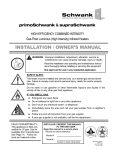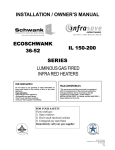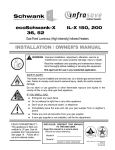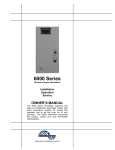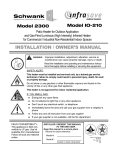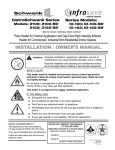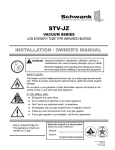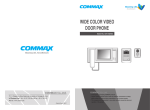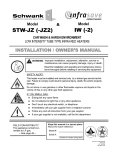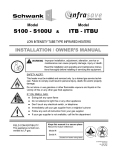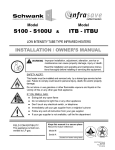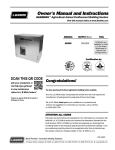Download Schwank 4N12-JSERIES Owner`s manual
Transcript
primoSchwank & supraSchwank HIGH EFFICIENCY COMBINED INTENSITY Gas-Fired Luminous (High Intensity) Infrared Heaters Certified by CSA International to ANSI Z83.19b / CSA 2.35b latest edition. INSTALLATION / OWNER’S MANUAL WARNING Improper installation, adjustment, alteration, service or maintenance can cause property damage, injury or death. Read the installation and operating and maintenance instructions thoroughly before installing or servicing this equipment. Not approved for use in any residential application. SAFETY ALERT: This heater must be installed and serviced only by a trained gas service technician. Failure to comply could result in personal injury, death, fire and/or property damage. Do not store or use gasoline or other flammable vapours and liquids in the vicinity of this or any other gas fired appliance. IF YOU SMELL GAS: Extinguish any open flame Do not attempt to light this or any other appliance Don’t touch any electrical switch, or telephone Immediately leave the area and call your gas supplier from a neighbor’s phone Follow any and all instruction from your gas supplier If your gas supplier is not available, call the fire department FIELD CONVERTIBILITY: This appliance is field convertible to LP gas. Use kit available from manufacturer. See Page 14. Follow all local and national codes. INSTALLER: PRESENT THIS MANUAL TO THE END USER. Keep this manual in a secure place . Record for future reference: Model #: Serial #: (located on heater rating label) supra/primo Manual IM091112 RD: APR 2013 RL: 13B NOTICE: This manual is current for this product. Occasional revision of the product Certification Standard may require changes to the product and/or this manual. This publication, or parts thereof, may not be reproduced in any form, without prior written consent from The Manufacturer. Unauthorized use or distribution of this publication is strictly prohibited. Schwank Group Schwank and InfraSave brands 5285 Bradco Boulevard Mississauga, Ontario,L4W 2A6 PO Box 988, 2 Schwank Way Waynesboro, Georgia 30830 Customer & Technical Services Phone: 877-446-3727 Fax: 866-361-0523 e-mail: [email protected] www.schwankgroup.com www.infrasave.com supra/primo Manual IM091112 RD: APR 2013 RL: 13B 2 primoSchwank supraSchwank HIGH EFFICIENCY COMBINED INTENSITY GAS FIRED INFRA-RED HEATERS TABLE OF CONTENTS TOPIC ........PAGE TOPIC ……...PAGE IMPORTANT INFORMATION - READ FIRST 11. INSTALLATION .............................................. 16 APPLICATION ..............................................4 DIMENSIONS & CAPACITIES ........................ 17 HEATER EXPANSION .................................5 SEISMIC & WIND SUSPENSION ................... 18 GAS CONNECTION ...............................5, 14 VENTING ................................................5, 13 12. LIGHTING INSTRUCTIONS ........................... 19 13. SHUT DOWN INSTRUCTIONS....................... 19 ‘SMOKE’ & DISCOLORATION ....................5 14. DISCOLORATION OF HEATER BODY .......... 19 CLEARANCE TO COMBUSTIBLES............6 Clearances Figure & Table ........................7 STACKING HEIGHT SIGN .......................8 WIRING DIAGRAMS 15. FENWAL CONTROL - 24V THERMOSTAT................. 20 16. FENWAL CONTROL - 120V THERMOSTAT ............... 21 1. GENERAL APPLICATION................................9 LABOR REQUIREMENTS................................9 17. SERVICE GUIDE............................................. 22 2. INSTALLATION IN AIRCRAFT HANGARS .....9 18. TROUBLESHOOTING GUIDE ........................ 23 3. INSTALLATION IN COMMERCIAL GARAGES ........................................................9 19. HIGH ALTITUDE INSTALLATION................... 26 4. INSTALLATIONS OTHER THAN SPACE HEATING ............................................9 20. SEQUENCE OF OPERATION ........................ 27 ORIFICE CHARTS.................................... 26 21. SPARK IGNITION CIRCUIT ............................ 28 5. PRE-INSTALLATION SURVEY......................10 22. START– UP / COMMISSIONING SHEET....... 29 6. MOUNTING CLEARANCES...........................11 23. OPTIONAL ACCESSORIES ........................... 30 SERVICE CLEARANCE.................................11 PRIMO SIDE SHIELD EXTENSIONS ............. 33 7. HEATER PLACEMENT GUIDELINES ...........12 SUPRA SIDE SHIELD EXTENSIONS............. 34 8. VENTILATION ................................................13 24. EXPLODED VIEW & PARTS LIST ................. 35 9. GAS SUPPLY & PIPING ................................14 WARRANTY STATEMENT ............ BACK PAGE GAS CONVERSION .....................................14 10. ELECTRICAL & THERMOSTAT ....................15 IMPORTANT Installer: Present this manual to the end user. Acquaint the end user with Important Information: Cover & pages 4 to 8. END USER: In particular you must be aware of ‘Clearances to Combustible’ requirements and the limitations of stacking or placing material near the heaters. Inform your safety personnel and staff of this information. 3 supra/primo Manual IM091112 RD: APR 2013 RL: 13B IMPORTANT Installer: Present this manual to the end user. Acquaint the end user with Important Information: Cover & pages 4 to 8. END USER: In particular you must be aware of ‘Clearances to Combustible’ requirements and the limitations of stacking or placing material near the heaters. Make your safety personnel and staff aware of this information. WARNING Improper installation, adjustment, alteration, service or maintenance can cause property damage, injury or death. Read and understand this installation and operation manual thoroughly prior to assembly, installation, operation or service to this appliance. This heater must be installed and serviced only by a trained gas service technician. Do not store or use gasoline or other flammable vapours and liquids in the vicinity of this or any other gas fired appliance. Failure to comply could result in personal injury, death, fire and/or property damage. Do not store or use gasoline or other flammable vapours and liquids in the vicinity of this or any other gas fired appliance. This appliance may have sharp edges and corners. Wear protective clothing such as gloves and protective eye wear when servicing this or any other appliance. APPLICATION This heater is certified to ANSI Z83.19b / CSA 2.35b latest edition. A gas-fired luminous (high intensity) radiant heater may be installed for heating of commercial / industrial non-residential spaces. It is beyond the scope of these instructions to consider all conditions that may be encountered. Installation must conform with all local building codes or, in the absence of local codes, with the National Fuel Gas Code, ANSI Z223.1/NFPA 54 in the U.S.A. or the Natural Gas and Propane Installation Code, CSA B149.1 in Canada. The latest edition Electrical Code ANSI/NFPA N0 70 in the U.S.A. and PART 1 CSA C22.1 in Canada must also be observed. Installation of a gas-fired radiant heater must conform to all heating installation design procedures including clearance to combustibles, connection to the gas and electrical supplies, and ventilation. This heater is not for installation in a Class 1 or Class 2 explosive environment, nor for any residential application. If installation of this equipment is in question, consult with local authorities having jurisdiction (Fire Marshall, labor department, insurance underwriter, or others). WARNING Revisions to codes and/or standards, may require revision to equipment and installation procedures. In case of discrepancy, the latest codes, standards, and installation manual will take priority over prior releases. IMPORTANT: DO NOT INSTALL THIS HEATER IN A STRUCTURE WITH NO INSULATION IN THE ROOF—CONDENSATION WILL OCCUR. supra/primo Manual IM091112 RD: APR 2013 RL: 13B 4 WARNING Heater Expansion It is a normal condition that during heat-up and cool-down a radiant heater will expand and contract. Allowances for heater expansion must be made in the gas connection and heater suspension. Improper installation, alteration, or adjustment can result in property damage, injury or death. WARNING Gas Connection Improper installation, connection, or adjustment can result in property damage, toxic gases, asphyxiation, injury or death. Use an approved stainless steel flexible gas connector (field supplied) to connect to the gas supply to the heater in accordance with all local, state, provincial, and national codes (ANSI Z223.1/NFPA 54 in USA; B149.1 in Canada) and as indicated in this manual. WARNING Venting Inadequate venting of a heater may result in asphyxiation, carbon monoxide poisoning, injury or death. This heater is indirectly vented from the space. Venting must be in accordance with all local, state, provincial, and national codes (ANSI Z223.1/NFPA 54 in USA; B149.1 in Canada) and as indicated in this manual. Refer to Sections 11 & 12 WARNING ‘Smoke’ & Discoloration Condition During start-up, the heating of material coatings used in the production process of the heater may create a small amount of smoke during the initial period of operation. This condition is normal and temporary . Ensure that there is sufficient ventilation to adequately clear any ‘smoke’ from the space. Notify site management and safety personnel to ensure that alarm systems are not unduly activated. Under certain conditions in some locations/environments, surface discoloration may occur on the heater body where the products of combustion discharge from the heater. This discoloration is due the deposit of ambient air borne particulate or gases that have passed through combustion. The combustion of fuel gas in a clean environment will not cause any discoloration. The discoloration does not affect the operation of the heater nor the manufacturer’s warranties. 5 supra/primo Manual IM091112 RD: APR 2013 RL: 13B WARNING Clearance to Combustibles Location of flammable or explosive objects, liquids or vapors close to the heater may cause fire or explosion and result in property damage, injury or death. Do not use, store or locate flammable or explosive objects, liquids or vapors in proximity of the heater. The clearance to combustible material represents the minimum distance that must be maintained between the outer heater surface and a nearby surface. The stated clearance to combustibles represents a surface temperature of 90F° (50C°) above room temperature. It is the installer’s responsibility to ensure that building materials with a low heat tolerance which may degrade at lower temperatures are protected to prevent degradation. Examples of low heat tolerance materials include vinyl siding, fabrics, some plastics, filmy materials, etc. In locations used for the storage of combustible materials, signs must be posted to specify the maximum permissible stacking height to maintain the required clearances from the heater to the combustibles. For your convenience, a sign is supplied with this heater - see page 8 for details. Such signs must either be posted adjacent to the heater thermostats or in the absence of such thermostats in a conspicuous location. In addition to stored or stationary material, consideration must also be given to moveable objects such as cranes, vehicles, and overhead doors, and structural objects such as electrical and gas lines, electrical fixtures, and sprinkler heads. Heaters must be located an appropriate distance from sprinkler heads. This distance may be greater than the certified clearance to combustibles. Check the temperature rating of the sprinkler heads and locate heaters at a safe distance - in some instances the sprinkler heads may need to be replaced by higher temperature heads. It is beyond the scope of these instructions to consider all conditions that may be encountered. Consult local authorities such as the Fire Marshall, insurance carrier, or safety authorities if you are uncertain as to the safety or applicability of the proposed installation. Refer to Figure 1 and Table 1 NEXT PAGE for the certified clearances to combustibles for the appropriate model input/size. supra/primo Manual IM091112 RD: APR 2013 RL: 13B 6 MOUNTING CLEARANCE TO COMBUSTIBLES NOTE: A ‘PEEL & STICK’ SIGN IS SUPPLIED: USE AN INDELIBLE MARKER TO ENTER VALUES ‘H’, ‘S’, ‘F’, & ‘B’ ON . POST THE SIGN ADJACENT TO THE HEATER THERMOSTAT OR IN A PROMINENT LOCATION. See next page for details. FIGURE 1: MINIMUM DISTANCES TO COMBUSTIBLES - refer to Table 1 for values SUSPENDED AT 30° SUSPENDED HORIZONTALLY A F A S A B A S T = Site distance to floor C Site distance to floor = T C TABLE 1: MINIMUM CLEARANCE TO COMBUSTIBLES SUSPENDED HORIZONTALLY: Measured from outer surface of heater BELOW ‘C’ SIDES ‘S’ TOP ‘A’ ENDS ‘E’ MODEL Inches [cm] Inches [cm] Inches [cm] Inches [cm] primoSchwank 10 primoSchwank 15 primoSchwank 20 primoSchwank 30 90" 96" 100" 105” [229] [244] [254] [267] 30” [76] 30” [76] 36” [91] 42” [107] 18" 18" 18" 18" [46] [46] [46] [46] 48" 48" 48" 48" [122] [122] [122] [122] supraSchwank 10 supraSchwank 15 supraSchwank 20 supraSchwank 30 90" 96" 100" 105” [229] [244] [254] [267] 30” 30” 33” 36” 16” 16” 16” 16” [41] [41] [41] [41] 48" 48" 48" 48" [122] [122] [122] [122] [76] [76] [84] [91] SUSPENDED AT AN ANGLE OF 30° *: Measured from outer surface of heater BELOW ‘C’ FRONT ‘F’ BACK ‘B’ TOP ‘A’ ENDS ‘E’ MODEL Inches [cm] Inches [cm] Inches [cm] Inches [cm] Inches [cm] primoSchwank 10 primoSchwank 15 primoSchwank 20 primoSchwank 30 67” 66” 70” 74” [170] [168] [178] [188] 67” 66” 70” 74” [170] [168] [178] [188] 8” 8” 8” 8” [20] [20] [20] [20] 24” 24” 24” 24” [61] [61] [61] [61] 48" 48" 48" 48" [122] [122] [122] [122] supraSchwank 10 supraSchwank 15 supraSchwank 20 supraSchwank 30 66” 66” 69” 72” [168] [168] [175] [183] 66” 66” 69” 72” [168] [168] [175] [183] 8” 8” 8” 8” [20] [20] [20] [20] 24” 24” 24” 24” [61] [61] [61] [61] 48" 48" 48" 48" [122] [122] [122] [122] NOTE: Suspended between horizontal and 30°: Use the largest clearance from each column ~ See additional notes on previous & next pages ~ 7 supra/primo Manual IM091112 RD: APR 2013 RL: 13B The clearance to combustible materials represents the minimum distance that must be maintained between the heater and a nearby surface. The stated clearance to combustibles represents a surface temperature of 90F° (50C°) above room temperature. It is the installer’s responsibility to ensure that building materials with a low heat tolerance which may degrade at lower temperatures are protected to prevent degradation. Examples of low heat tolerance materials include vinyl siding, fabrics, some plastics, filmy materials, etc. WARNING In locations used for the storage of combustible materials signs must be posted specifying the maximum permissible stacking height to maintain the required clearances from the heater to the combustibles. The signs must be posted either adjacent to the IR heating system thermostats or in the absence of such thermostats, in a conspicuous place. For your convenience a “peel and stick” sign is provided with this heater. Use a permanent marker to record the required dimensions on the sign. To calculate the value ‘H’ ( Maximum Material Stacking Height): Maximum Material Stacking Height: H = T (distance from heater to floor) minus C (the combustibles clearance below the heater) or H = T - C Measure the on-site distance between bottom of the heater and the floor = ‘T’ inches (cm). Refer to Table 1 to get the value ‘C’ (clearance to combustibles below heater) that corresponds to the model you are installing Subtract the clearance below the heater ‘C’ from ‘T’ to get value ‘H’ (maximum material stacking height). Enter this value ‘H’ on the sign with permanent marker. Then, for the heater model/size being installed, refer to the information in Figure 1 and Table 1 to get the values for dimensions ‘S’, ‘F’ and ‘B’ (F and B are for ‘angle mounted’ heaters only). supra/primo Manual IM091112 RD: APR 2013 RL: 13B 8 Post this sign as instructed above. 1. GENERAL APPLICATION A gas-fired radiant heater may be installed for heating of commercial / industrial non-residential spaces. It is beyond the scope of these instructions to consider all conditions that may be encountered. Installation must conform with all local building codes or, in the absence of local codes, with the National Fuel Gas Code, ANSI Z223.1/NFPA 54 in the U.S.A. or the Natural Gas and Propane Installation Code, CSA B149.1 in Canada. The latest edition Electrical Code ANSI/NFPA N0 70 in the U.S.A. and PART 1 CSA C22.1 in Canada must also be observed. Installation of a gas-fired radiant heater must conform to all heating installation design procedures including clearance to combustibles, connection to the gas and electrical supplies, and ventilation. This heater is not for installation in a Class 1 or Class 2 explosive environment, nor a residence. If installation of this equipment is in question, consult with local authorities having jurisdiction (Fire Marshall, labor department, insurance underwriter, or others). Revisions to codes and/or standards, may require revision to equipment and installation procedures. In case of discrepancy, the latest codes, standards, and installation manual will take priority over prior releases. Models primoSchwank and supraSchwank may be installed for heating of commercial / industrial non-residential indoor spaces. IMPORTANT: DO NOT INSTALL THIS HEATER IN A STRUCTURE THAT HAS NO INSULATION IN THE ROOF - CONDENSATION WILL OCCUR. This heater must not be installed inside a degreasing plant, nor in an area where chlorine, fluorine or bromine are present. LABOR REQUIRMENTS Two persons are required to safely install this equipment. Wear gloves and other required safety protection. 2. INSTALLATION IN COMMERCIAL AIRCRAFT HANGARS Luminous (high intensity) radiant tube heaters are suitable for use in aircraft hangars when installed in accordance with the latest edition of the Standard for Aircraft Hangars, ANSI/NFPA No 409 in the USA, or the Canadian Natural Gas and Propane Installation Code, B149.1. A. A minimum clearance of 10 ft (3 m) above either the highest fuel storage compartment or the highest engine enclosure of the highest aircraft which may occupy the hangar. The clearance to the bottom of the heater shall be measured from the upper surface of either the fuel storage compartment or the engine enclosure, whichever is higher from the floor. B. A minimum clearance of 8 ft (2.4 m) must be maintained from the bottom of the heater to the floor in other sections of the aircraft hangar, such as offices and shops, which communicate with areas for servicing or storage. Refer to Table 1 for proper mounting clearances to combustibles. C. Heaters must be located so as to be protected from damage by aircraft and other objects, such as cranes and movable scaffolding. D. Heaters must be located so as to be accessible for servicing and adjustment. 9 supra/primo Manual IM091112 RD: APR 2013 RL: 13B 3. INSTALLATION IN COMMERCIAL GARAGES AND PARKING STRUCTURES Luminous (high intensity) radiant heaters are suitable for use in commercial garages when installed in accordance with the latest edition of the Standard for Parking Structures, ANSI/NFPA 88A, or the Standard for Repair Garages, ANSI/NFPA No. 88B, or the Canadian Natural Gas and Propane Installation Code, B149.1. WARNING An overhead heater shall be located high enough to maintain the minimum distance to combustibles, as shown on the heater rating plate, from the heater to any vehicles parked below the heater. Overhead heaters shall be installed at least 8 ft (2.4 m) above the floor. 4. INSTALLATIONS OTHER THAN SPACE HEATING Use for process or other applications that are not space heating will void the C.S.A. certification and product warranty. Process application requires field inspection and/or certification by local authorities having jurisdiction. Process application design should be provided by local experienced process design experts. 5. PRE INSTALLATION SURVEY It is recommended that a full heating design including heat loss calculation be conducted on the structure or area to be heated. Heater sizing and placement must consider available mounting height, sources of greatest heat loss, and obstructions on the site. The certified clearances to combustibles with respect to stored material, moveable objects (cranes, vehicles, lifts, overhead doors, etc), structural components, and sprinkler system heads. Consideration must also be given to ventilation fan placement. Carefully survey the area to be heated, and for best results place heaters in the coldest area(s) and at sufficient spacing to provide radiant heat coverage. Installation must conform with all local, state, provincial and national code requirements including the current latest edition ANSI Z223.1 (NFPA 54) in the U.S.A. and B149.1 installation code in Canada, for gas burning appliances and equipment. The latest edition Electrical Code ANSI/NFPA N0 70 in the U.S.A. and PART 1 CSA C22.1 in Canada must also be observed. The heating system must have gas piping of the correct diameter, length, and arrangement to provide for the total system input. A layout drawing is necessary to calculate properly sized gas supply piping. supra/primo Manual IM091112 RD: APR 2013 RL: 13B 10 6. MOUNTING CLEARANCES This heater must be mounted with at least the minimum clearances between the heater and combustibles as shown in FIG-1, TABLE 1, Page 7. The clearances to combustible material represent a surface temperature of 90 F° (50 C°) above ambient. It is the installer’s responsibility to ensure that building materials with a low heat tolerance which may degrade at lower temperatures are protected to prevent degradation. Positioning of lights, sprinkler heads, overhead doors, storage areas, gas and electrical lines, parked vehicles, cranes and any other possible obstruction or hazard must be evaluated prior to installation. Ensure adequate clearance around the air intake at the burner to allow sufficient combustion air supply to the heater. 6A. SERVICE CLEARANCE: To allow servicing of burner and controls, provide a minimum clearance of 24 inches (61 cm) from the gas supply / ignition-controls of the heater to a wall or obstruction . (see Figure 2 below) - the minimum clearances to combustibles must always be maintained. For guidelines to heater placement refer to TABLE 2 (next page). FIGURE 2: SERVICE CLEARANCE 7. HEATER MOUNTING / PLACEMENT The primoSchwank / supraSchwank Combined Intensity Heaters are approved for both horizontal and angle mounting. IMPORTANT: When angle mounting, the short axis may be rotated to a maximum of 30° with the venturi always in the upper position. Improper angle mounting can result in damage to the heater or unsafe operation. For either horizontal or angle mounting, the long axis of the heater must be level. Use only non-combustible mounting hardware. See FIGURE 3 and TABLE 2 next page for ‘Typical Layout Mounting Distances’ 11 supra/primo Manual IM091112 RD: APR 2013 RL: 13B TABLE 2: SUGGESTED LAYOUT MOUNTING DISTANCES FOR COMFORT* SUSPENDED HORIZONTALLY TO 30°: MODEL primoSchwank or supraSchwank TYPICAL ABOVE FLOOR <X> 10 15 20 30 15' (460 cm) 18' (550 cm) 20' (610 cm) 24' (730 cm) TYPICAL BETWEEN HEATERS <Y> TYPICAL BETWEEN ROWS <Z> 25' (760 cm) 30' (915 cm) 35' (1070 cm) 45' (1370 cm) 30' (915 cm) 40' (1220 cm) 50' (1525 cm) 70' (2135 cm) SUSPENDED AT AN ANGLE** 30° TO 45°: MODEL primoSchwank or supraSchwank TYPICAL ABOVE FLOOR <X> 10 15 20 30 13' (400 cm) 16' (490 cm) 18' (550 cm) 21' (640 cm) TYPICAL BETWEEN HEATERS <Y> TYPICAL BETWEEN ROWS <Z> 25' (760 cm) 30' (915 cm) 35' (1070 cm) 45' (1370 cm) 50' (1525 cm) 75' (2290 cm) 100' (3050 cm) 140' (4270 cm) FIGURE 3: SUGGESTED SPACING FOR COMFORT Y Long axis always level X Venturi in upper position Z Z X X Short axis may rotate up to 30° * The Mounting distances are suggested, and may vary depending on insulation values, air movement / change, and other site conditions. If in doubt, please contact Schwank Technical Services. For ‘spot’ heating, the distance above the floor can be reduced by 2 to 4 feet (61 to 132 cm) depending upon site conditions. ** IMPORTANT: When angle mounted the gas-inlet/venturi side of the heater MUST BE IN THE UPPER POSITION. supra/primo Manual IM091112 RD: APR 2013 RL: 13B 12 8. VENTILATION WARNING Inadequate venting of a heater may result in asphyxiation, carbon monoxide poisoning, injury or death. Heating system venting must be in accordance with all local, state, provincial, and national codes (ANSI Z223.1/NFPA 54 in USA; B149.1 in Canada). This heater is approved for unvented (indirect venting) application. Ensure that there is adequate ventilation to supply combustion air and to dilute the products of combustion in accordance with all local, state, provincial, and national codes. A balanced exhaust / inlet air system is required to ensure that a negative air condition is not created. See below for a summary of exhaust capacity requirements by the national codes in the U.S.A. and Canada. Air Supply: “Loose” buildings may not require any additional air supply if infiltration rates are sufficient. However, for “tighter” buildings, or if air movement is stagnant in an area, air can typically be supplied via inlet(s) with an area of 1 sq. in. per 1,000 Btuh input (22 sq cm per kW). Locate air inlet(s) up at the level of the heaters to avoid cold drafts at work level, and effectively supply combustion and dilution air to the heaters and balance the system. Heater Zoning: Exhausters are sized according to the input requirements of each controlled zone of heaters. Multiple smaller zones are usually more effective in both comfort and ventilation control than one large zone. Maximum zone size is limited by the total input that can be handled by the capacity of an exhauster, and by the proximity of the exhauster to heaters in the zone. Exhauster Location & Proximity: Exhaust must be located as high as practicable in the structure above the level of the heater(s) to effectively dilute and remove the warm (rising) products of combustion. The exhauster should be as centrally located as practicable in the zone of heaters. Schwank recommends a maximum 6:1 ratio of the horizontal distance between the exhauster and the furthest heater in a zone, to the height the heaters are mounted above the floor . For example, if heaters are mounted 20 ft above the floor, then the exhaust fan should be located no more than 120 ft from the furthest heater in the zone. Sufficient air supply must be provided. Exhauster Capacity: USA: Natural or mechanical means shall be provided to supply and exhaust at least 4ft3/min/1000Btuh (0.38m3/min/kW) Natural Gas input of installed heaters [4.5ft3/ min/1000Btuh (0..43m3/min/kW) Propane input]. Some local codes may require an interlock to a dedicated exhaust fan. Consult your local code and ANSI Z223.1 latest edition for all venting requirements and practices. Canada: It is required that the heater(s) be electrically interlocked to dedicated exhaust fan(s) by means of an Air Proving Switch. Exhaust fan(s) must be sized to create 300 cfm (8.5 cu m/min) exhaust for every 100,000 Btuh (30 kW) or any fraction thereof of total input of installed equipment. Provide combustion and ventilation air supply compatible with exhaust volume . Consult the latest edition of CSA.B149.1 Section 7.22. 13 supra/primo Manual IM091112 RD: APR 2013 RL: 13B 9. GAS SUPPLY PIPING WARNING Install and connect gas lines in accordance with local, state, provincial and national codes (ANSI Z223.1/NFPA 54 in USA; B149.1 in Canada). Incorrect installation and connection of gas lines may results in fire, explosion, property damage, injury or death Do not install any gas piping or wiring in the heat zone directly above the heater. Do not subject heater controls to leak test pressures when checking the main supply piping. A. Gas piping must be sized to provide adequate input capacity to all heaters and appliances in the system and at the pressure indicated in Table 3 below. IMPORTANT: Minimum supply line pressure at the inlet to the heater regulator must not be lower than 6.0 inches of water column pressure for natural gas and 12” w.c. for propane. The supply gas pressure must be checked with all heaters in operation. B. Provide a 1/8 in (3.2 mm) NPT plugged tapping, accessible for test gauge connection, immediately upstream of the gas supply connection to the heater. C. It is recommended to install an approved flexible connector between the heater and gas piping - available as option from Schwank or from your local supplier. D. A drip-leg prior to the inlet connection to the heater must be provided in the gas line. E. On propane-fired units, a main line filter is recommended. F. Piping joint compounds must be resistant to the action of natural gas or LPG G. TEST FOR LEAKS: Apply soap suds solution to all connections and joints and if bubbles appear, leaks have been detected and must be corrected. DO NOT USE A MATCH OR OPEN FLAME OF ANY KIND TO TEST FOR LEAKS. NEVER OPERATE THE HEATER WITH LEAKING CONNECTIONS. Leak test according to local or national codes. DO NOT use pressure greater than 1/2 psig to pressure check the heater. The supply system should be checked first with heater turned “OFF” followed by another check with heater turned “ON”. WARNING GAS CONVERSION This heater may be field converted from one fuel gas to another (natural gas or LPG). Conversion must be accomplished with a kit available from the manufacturer . Contact your local distributor for the kit that is specific to the model installed. Conversion may include changing of the air restrictor as well as the orifice and gas valve spring. Follow the instructions supplied with the conversion kit. Gas conversion must only be done by a trained gas service technician, according to all local and national codes. Incorrect conversion may result in fire, explosion, property damage, injury or death supra/primo Manual IM091112 RD: APR 2013 RL: 13B 14 GAS SUPPLY PRESSURE: The maximum supply pressure must be limited to 14 inches w.c. (0.51 psi). If the line pressure is above 14 inches w.c. then a separate pressure reducing regulator must be used - follow all codes. The minimum pressure at the inlet to the heater regulator must be equal to or greater than 6.0 inches w.c. for NG and 12 inches w.c. for LP. A sealed regulator is supplied with the heater which maintains the proper manifold pressure when the main burner is operating under the following pressures: TABLE 3 LINE PRESSURE ( “ w.c.) MANIFOLD PRESSURE inches w.c. AT TAP IN GAS VALVE MINIMUM MAXIMUM NATURAL GAS 6.0 14.0 5.0 PROPANE GAS 11.0 14.0 10.0 10 ELECTRICAL REQUIREMENTS AND THERMOSTAT CONTROL All electrical installations must meet local codes and the latest edition Electrical Code PART 1 CSA C22.1 in Canada and ANSI/NFPA N0 70 in the U.S.A.. TRANSFORMER SPECIFICATIONS Single heater requires 24 Volt, 60 Hz electrical transformer sized at 40 VA. Multiple heaters in a zone are powered by a single transformer. The proper transformer is 24 Volt AC, 60 Hz, sized at 40 VA for the first heater plus 20VA for each additional heater in the zone - round up the calculated value to the next higher available sized transformer. For example, four heaters in a zone require a transformer of : 1 x 40VA + 3 x 20 VA = 100 VA . It is not recommended to install more than 12 heaters per zone. PROPER WIRING POLARITY MUST BE MAINTAINED, particularly when grouping the heaters in a zone. Total wiring distances of up to 200' must use minimum 16 gauge electrical wire, and wiring distances of over 200' must use minimum 14 gauge electrical wire. The heater must be electrically grounded in accordance with local and national electrical codes. Malfunction of the heating system will result if the voltage varies by more than +10% or -10%. The heater can be controlled by a line voltage thermostat, a 24 volt thermostat or “off-on” switch. Total load of all heaters must be considered in determining the required contact rating of the controlling thermostat or switch. 15 supra/primo Manual IM091112 RD: APR 2013 RL: 13B 11. INSTALLATION A. Properly size and install ventilation as per Section 8, gas supply as outlined in Section 9, previous page, and electrical supply as per Section 10 above. B. Ensure adequate clearance around air openings into the combustion chamber C. The ignition control assembly is shipped in the carton with the heater. Assemble the gas valve / ignition control assembly to the heater at the gas-supply union. D. Suspended infrared heaters shall be fixed in position independent of gas and electric supply lines. Hangers and brackets shall be of non-combustible material. Heaters subject to vibration shall be provided with vibration-isolating hangers. E. Suspension hardware must be of adequate capacity to support the weight of the heater see Table 4 next page. Typical suspension chain is #8 Jack Chain (60 lb work load rating) and/or #2 Lion Chain (also called “Double Loop” Chain) (115 lb work load rating). F. For Seismic & Wind condition suspension see Figure 7 page 18 G. Mounting at an angle of up to 30°: see Figure 6 page 18 Rotate on the short axis only - long axis must always be horizontal The venturi side of the heater must be in the upper position when angle mounted The ‘center of gravity’ of the heater allows angle mounting up to 30° using the suspension tabs attached to the heater E. Mounting at an angle greater than 30° up to 45°: see Figure 6 page 18 Rotate on the short axis only - long axis must always be horizontal The gas-supply/venturi side of heater must be in the upper position when angle mounted The heater requires an Angle Mounting Bracket (JO-0331-XX - available as an optional accessory) for angle mounting over 30° up to 45° - the Angle Mounting Bracket bolts to the suspension tabs on the heater - see Figure 6 page 18 F. Mount heaters to structure by using non-combustible mounting hardware such as that illustrated in FIGURE 5 on page 18. G. Observe the minimum clearances to combustibles as per the Clearance To Combustibles section and Figure 1 and Table 1 pages 6, 7. H. In locations used for the storage of combustible materials, signs shall be posted to specify the maximum permissible stacking height to maintain required clearances from the heater to the combustible materials. SEE PAGE 8 I. Connect heater to the main gas line. It is recommended to use a 1/2" flexible connector (available as option from Schwank) to absorb gas line expansion and any vibration from the building. The flexible gas connector must be formed into a smooth ‘C’ shape. J. Mount thermostat at desired location, away from direct infra-red rays of heater. If the thermostat is located on a cold wall, place sufficient insulation behind the thermostat. K. Test gas line for leaks by using gas pressure test and/or soap test and as per all local and national codes. Ensure gas pressure meets the requirements outlined in Section 9. When testing the main gas line pressure, ensure the gas shut-off valve is “OFF”, otherwise damage to the combination gas valve can result. L. Test fire the heating system by following the lighting instructions on the next page and on heater. supra/primo Manual IM091112 RD: APR 2013 RL: 13B 16 FIGURE 4: DIMENSIONS: primoSchwank & supraSchwank TABLE 4: DIMENSIONS / WEIGHT / CAPACITY primoSchwank MODEL primoSchwank 10 primoSchwank 15 primoSchwank 20 primoSchwank 30 supraSchwank MODEL supraSchwank 10 supraSchwank 15 supraSchwank 20 supraSchwank 30 ‘A’ In. [cm] ‘S’ In. [cm] 23.75" 21.7" [60.3] [55.1] 34.50" 32.6" [87.6] [82.8] 45.62" 43.5" [116] [110.5] 67.32" 65" [171] [165] ‘A’ In. [cm] ‘S’ In. [cm] 23.87" 21.7" [60.6] [55.1] 34.60" 32.6" [87.9] [82.8] 45.75" 43.5" [116] [110.5] 67.5" 65" [171] [165] CAPACITY WEIGHT Lbs. [kg] GAS TYPE INPUT Btuh [kW] IR OUTPUT Btuh [kW] 23.5 [10.7] 33.6 [15.2] 40.3 [18.3] 54.9 [24.9] NG LPG NG LPG NG LPG NG LPG 37,500 [11] 34,100 [10] 56,000 [16] 51,000 [15] 75,000 [22] 68,500 [20] 113,000 [33] 103,000 [30] 24,600 [7.2] 22,370 [6.6] 35,400 [10.4] 32,230 [9.4] 49,050 [14.4] 44,800 [13.1] 76,500 [22.4] 69,730 [20.4] CAPACITY WEIGHT Lbs. [kg] GAS TYPE INPUT Btuh [kW] IR OUTPUT Btuh [kW] 37 [17] 53 [24] 62 [28] 82 [37] NG LPG NG LPG NG LPG NG LPG 29,500 [9] 27,000 [8] 44,000 [13] 40,500 [12] 59,000 [17] 54,500 [16] 88,500 [26] 81,500 [24] 22,800 [6.7] 20,850 [6.1] 34,630 [10.1] 31,870 [9.3] 46,730 [13.7] 43,160 [12.6] 71,700 [21.0] 66,100 [19.4] 17 supra/primo Manual IM091112 RD: APR 2013 RL: 13B FIGURE 5: TYPICAL SUSPENSION HARDWARE (supplied by others) EYE BOLT THRU BEAM BEAM CLAMP EYE OR HOOK FIGURE 6: SUSPENDING HEATER FIGURE 7: SEISMIC & WIND SUSPENSION supra/primo Manual IM091112 RD: APR 2013 RL: 13B 18 PIPE RING BAR JOIST CLAMP 12. LIGHTING INSTRUCTIONS A Open the isolation valve in the main gas line and turn gas control knob on the combination gas valve to the “ON” position. B Switch on electrical circuit by turning the thermostat to the highest temperature setting. C The heater should attempt ignition and remain lit within thirty seconds. Note that the corresponding exhaust fan is operating properly. D If ignition does not occur, then cut off electrical power by turning the thermostat to off position. WARNING If heater back-fires during operation it must be turned off immediately. Indication of back-firing: A. Loud ignition noise, then followed by distinct hissing sound. B. Little or no visible burning on the ceramic tile. C. Combustion is taking place inside the burner body. Cause & remedy of back-firing: A. Improper gas pressure entering the venturi tube = test & remedy gas pressure. B. Breakage of a ceramic tile and or gasket = replace damaged part. C. Faulty sealing of the ceramic tile to the burner body, caused by breakdown of gasket material = contact your Schwank distributor. 13. SHUT DOWN INSTRUCTIONS A. Turn off electrical circuit for temporary shutdown. B. Turn off the electrical circuit, close gas stop-cock in gas supply line, and turn gas control knob to the “OFF” position for complete shut-down. 14. DISCOLORATION OF HEATER BODY Under certain conditions in some locations/environments, surface discoloration may occur on the heater body where the products of combustion discharge from the heater. This discoloration is due the deposit of ambient air borne particulate or gases that have passed through combustion. The combustion of fuel gas in a clean environment will not cause any discoloration. The discoloration does not affect the operation of the heater nor the manufacturer’s warranties. 19 supra/primo Manual IM091112 RD: APR 2013 RL: 13B 15. FENWAL 35-60 - WIRING DIAGRAM - 24V CONTROL (Honeywell Control previous page) Fenwal Control Terminal Designation TH Thermostat / 24V Supply Input GND System Ground V1 Valve Power V2 24V Supply Neutral NC Alarm LED S1 Remote Flame Sensor Steady on Internal Control Failure supra/primo Manual IM091112 RD: APR 2013 RL: 13B 20 Error Mode 2 flashes Flame with No Call for heat 3 flashes Ignition Lockout 16. FENWAL 35-60 - WIRING DIAGRAM - 120V CONTROL (Honeywell Control previous page) LED Error Mode Steady on Internal Control Failure 2 flashes Flame with No Call for heat 3 flashes Ignition Lockout 21 supra/primo Manual IM091112 RD: APR 2013 RL: 13B 17. SERVICE GUIDE WARNING Improper installation, adjustment, alteration, service or maintenance can cause property damage, injury or death. Read and understand this installation and operation manual thoroughly prior to assembly, installation, operation or service to this appliance. This heater must be installed and serviced only by a trained gas service technician. Do not store or use gasoline or other flammable vapours and liquids in the vicinity of this or any other gas fired appliance. Failure to comply could result in personal injury, death, fire and/or property damage. Do not store or use gasoline or other flammable vapours and liquids in the vicinity of this or any other gas fired appliance. This appliance may have sharp edges and corners. Wear protective clothing such as gloves and protective eye wear when servicing this or any other appliance. Servicing of heater is essential for continued efficient operation. Servicing should be performed at minimum annually by qualified service personnel. A. Visually inspect the tiles for cracks or blockage: A crack or blockage will appear as a ‘dark’ line or spot on the tile surface during operation B. Clean the ceramic tile with compressed air. Avoid directing air stream at the gasket material between tile and heater body. The air pressure must be lower than 20 psi. C. Clean the venturi tube with compressed air. D. Clean the reflectors. E. Confirm gas and electrical supplies are at required settings - see Sections 9 and 10 F. Ensure that the gas valve is operating properly and that no particulate matter is fouling the seating of the valve and allowing gas leakage - replace valve if necessary. supra/primo Manual IM091112 RD: APR 2013 RL: 13B 22 18. TROUBLESHOOTING GUIDE SET THERMOSTAT TO CALL FOR HEAT IS THE HEATER BURNING? THE SYSTEM STOP. YES IS WORKING PROPERLY. NO →CHECK FOR DARK SPOTS OR LINES ON THE TILE SURFACE →’DARK’ AREAS REPRESENT CRACKS OR BLOCKAGE OF THE TILE →SEE ’SERVICE’ SECTION 15 IS THERE LINE VOLTAGE TO THE THERMOSTAT CONTROL? →CHECK CIRCUIT BREAKERS OR FUSE →CHECK ON/OFF SWITCH →CHECK NIGHT TIME SET BACK CONTROL NO YES →CHECK ELECTRICAL CONNECTION FROM THERMOSTAT TO FAN MOTOR →CHECK THERMOSTAT, REPLACE IF NECESSARY IS THERE VOLTAGE TO THE FAN SYSTEM? NO YES →CHECK EXHAUST FAN MOTOR, REPLACE IF NECESSARY IS FAN MOTOR OPERATING? NO YES IS THERE VOLTAGE TO THE TRANSFORMER? →CHECK ELECTRICALCONNECTION TO TRANSFORMER →CHECK LINE VOLTAGE TO PRIMARY SIDE OF TRANSFORMER NO YES IS THERE VOLTAGE FROM TRANSFORMER TO AIR-PROVING SWITCH? →CHECK ELECTRICAL CONNECTION FROM TRANSFORMER TO AIR SWITCH →CHECK TRANSFORMER, REPLACE IF NECESSARY NO YES CONT’D 23 supra/primo Manual IM091112 RD: APR 2013 RL: 13B IS THERE VOLTAGE FROM AIRPROVING SWITCH TO IGNITION CONTROL MODULE? NO YES →CHECK ELECTRICAL CONNECTION FROM AIR SWITCH TO IGNITION CONTROL MODULE. →ENSURE LOW VOLTAGE WIRES ARE PROPERLY INSTALLED, WIRING POLARITY IS CRITICAL →CHECK VA RATING ON THE TRANSFORMER. →ENSURE AIR HOSE IS CONNECTED PROPERLY FROM A I R SWITCH TO EXHAUST FAN →CHECK AIR SWITCH, REPLACE IF NECESSARY →ENSURE THE IGNITER GAP IS 1/4" WIDE (6MM) →ENSURE THE FLAME SENSOR IS WITHIN 1/4” TO 1/8" ABOVE CERAMIC TILE →CHECK SPARK IGNITER CE RAMIC FOR CRACK, REPLACE SPARK IGNITER IF NECES SARY →CHECK HI-VOLTAGE WIRE C O N N E C T I O N FROM SPARK IGNITER TO IGNITION MODULE →ENSURE HIGH VOLTAGE S P A R K S ARE GENERATED ON THE IGNITION CONTROL TERMINAL BY FOLLOWING THE STEPS AS SHOWN BELOW: -SHUT OFF ELECTRICAL POWER -REMOVE THE HI-VOLTAGE WIRE ON THE IGNITION CONTROL TERMINAL IS THERE A SPARK AT IGNITION SPARK IGNITER? NO YES WARNING: BEFORE REMOVING HI-VOLTAGE WIRE, ELECTRICAL POWER TO THE SYSTEM MUST BE SHUT OFF. THIS TERMINAL CARRIES 15,000 AC VOLTS. TURN ON ELECTRICAL POWER PLACE A METAL CONDUCTOR 1/8" AWAY FROM THE HI-VOLTAGE TERMINALS WARNING: THE HANDLE ON THE METAL CONDUCTOR MUST BE HEAVILY INSULATED. A LONG SCREW DRIVER WITH THICK PLASTIC INSULATION HANDLE IS IDEAL FOR THIS APPLICATION. IF NO SPARKING OCCURS ACROSS THE GAP TO THE METAL CONDUCTOR, THEN THE IGNITION CONTROL IS DEFECTIVE. REPLACE WITH NEW IGNITION CONTROL. SHUT OFF ELECTRICAL POWER AND RECONNECT THE HI-VOLTAGE WIRE. CONT’D supra/primo Manual IM091112 RD: APR 2013 RL: 13B 24 →CHECK ELECTRICAL WIRES FROM IGNITION IS THERE VOLTAGE FROM IGNITION CONTROL TO COMBINATION GAS VALVE? CONTROL TO COMBINATION GAS VALVE →CHECK IGNITION CONTROL, REPLACE IF NO NECESSARY YES IS GAS COMING THROUGH ORIFICE ON THE HEATER? →ENSURE ALL GAS VALVES ARE OPEN NO YES →CHECK SPARK IGNITER FOR CRACKS, DOES THE IGNITION CONTROL TERMINATE THE SPARKING PROCESS AFTER THE HEATER IS OPERATING? REPLACE SPARK IGNITER IF NECESSARY →ENSURE THE SENSING WIRE IS SECURELY CONNECTED TO THE SENSING PROBE →CLEAN THE SENSING PROBE ON THE SPARK IGNITER →ENSURE THE FLAME SENSOR IS WITHIN 1/4" ABOVE THE CERAMIC TILE →CHECK FLAME SIGNAL WITH METER, IF LOW CHANGE SENSOR →REPLACE WITH NEW IGNITION CONTROL UNIT IF OTHER CHECKS ARE OK NO YES DOES HEATER SHUT DOWN AFTER IGNITION CEASES? →CHECK FLAME SIGNAL USING A METER INSTALLED IN SERIES WITH SENSOR CABLE, CHECK (MICROAMPS) STRENGTH OF SIGNAL FOR 1.5uA MINIMUM YES NO STILL HAVING TROUBLE OPERATING THE HEATER? →IF SIGNAL IS LOW REPLACE SENSOR AND WIRE →REPEAT THE ABOVE TROUBLE SHOOTING PROCEDURES →IF THE PROBLEM PERSISTS, CONTACT YOUR SCHWANK DISTRIBUTOR. YES NO TROUBLESHOOTING COMPLETE 25 supra/primo Manual IM091112 RD: APR 2013 RL: 13B 19. HIGH ALTITUDE INSTALLATION This heater not to be installed at altitude above: NG = 6,800 feet; LPG = 4,500 feet USA: The factory installed orifice for this appliance is approved for altitudes zero to 2000 feet above sea level. When installed above 2000 feet, refer to information below. Canada: The factory installed orifice for this appliance is approved for altitudes zero to 4500 feet above sea level. When installed above 4500 feet, refer to information below. When this appliance is installed above the standard altitude stipulated for the USA or Canada, the input must be de-rated by 4% for each 1000 ft above sea level. The orifice must be changed according to the chart below - ensure you search the correct model. Check with your local utility regarding the gas supply and the de-rating of this appliance. FOR USE AT ALTITUDES ABOVE (FEET) Gas Orifice Drill Size / Part# MODEL Supplied USA Only 0 2000 primoSchwank 10 NG 2.65 mm JO-0310-NG 2.60 mm JO-1260-MM 2.57 mm 2.53 mm 2.49 mm 2.45 mm JO-1257-MM JO-1253-MM JO-1249-MM JO-1245-MM primoSchwank 10 LPG 1.67 mm JO-0310-LP 1.64 mm JO-1164-MM 1.62 mm 1.60 mm JO-1162-MM JO-1160-MM primoSchwank 15 NG 3.20 mm JO-0313-NG 3.14 mm JO-1314-MM 3.10 mm 3.06 mm 3.01 mm 2.96 mm JO-1310-MM JO-1306-MM JO-1301-MM JO-1296-MM primoSchwank 15 LPG 2.10 mm JO-0313-LP 2.06 mm JO-1206-MM 2.04 mm 2.01 mm JO-1204-MM JO-1201-MM primoSchwank 20 NG 3.75 mm JO-0311-NG 3.68 mm JO-1368-MM 3.64 mm 3.59 mm 3.53 mm 3.48 mm JO-1364-MM JO-1359-MM JO-1353-MM JO-1348-MM primoSchwank 20 LPG 2.43 mm JO-0311-LP 2.39 mm JO-1239-MM 2.36 mm 2.32 mm JO-1236-MM JO-1232-MM primoSchwank 30 NG 4.55 mm JO-0312-NG 4.47 mm JO-1447-MM 4.41 mm 4.35 mm 4.29 mm 4.22 mm JO-1441-MM JO-1435-MM JO-1429-MM JO-1422-MM primoSchwank 30 LPG 2.90 mm JO-0312-LP 2.84 mm JO-1284-MM 2.81 mm 2.77 mm JO-1281-MM JO-1277-MM supraSchwank 10 NG 2.35 mm JU-0319-NG 2.31 mm JU-1231-MM 2.28 mm 2.25 mm 2.21 mm 2.18 mm JU-1228-MM JU-1225-MM JU-1221-MM JU-1218-MM supraSchwank 10 LPG 1.50 mm JU-0319-LP 1.47 mm JU-1147-MM 1.45 mm 1.43 mm JU-1145-MM JU-1143-MM supraSchwank 15 NG 2.85 mm JU-0318-NG 2.80 mm JU-1280-MM 2.76 mm 2.73 mm 2.68 mm 2.64 mm JU-1276-MM JU-1273-MM JU-1268-MM JU-1264-MM supraSchwank 15 LPG 1.85 mm JU-0318-LP 1.82 mm JU-1182-MM 1.79 mm 1.77 mm JU-1179-MM JU-1177-MM supraSchwank 20 NG 3.35 mm JU-0320-NG 3.29 mm JU-1329-MM 3.25 mm 3.20 mm 3.16 mm 3.10 mm JU-1325-MM JU-1320-MM JU-1316-MM JU-1310-MM supraSchwank 20 LPG 2.18 mm JU-0320-LP 2.14 mm JU-1214-MM 2.11 mm 2.08 mm JU-1211-MM JU-1208-MM supraSchwank 30 NG 4.05 mm JU-0319-NG 3.98 mm JU-1398-MM 3.93 mm 3.87 mm 3.81 mm 3.75 mm JU-1393-MM JU-1387-MM JU-1381-MM JU-1375-MM supraSchwank 30 LPG 2.60 mm JU-0319-LP 2.55 mm JU-1255-MM 2.52 mm 2.49 mm JU-1252-MM JU-1249-MM 26 4000 5000 6000 DO NOT INSTALL DO NOT INSTALL DO NOT INSTALL DO NOT INSTALL DO NOT INSTALL DO NOT INSTALL DO NOT INSTALL DO NOT INSTALL DO NOT INSTALL AT ALTITUDE ABOVE 6,800 FEET supra/primo Manual IM091112 RD: APR 2013 RL: 13B 3000 USA & CANADA* 20. SEQUENCE OF OPERATION FOR FENWAL 35-60 DSI CONTROL Start up - Heat Mode: On a call for heat the Fenwal 35-60 control will reset, perform a self check routine, flash the diagnostic LED for up to four seconds. The gas valve and spark are energized commencing the trial for ignition period. When flame is detected during the trial for ignition, spark is shutoff immediately and the gas valve remains energized. The thermostat and main burner flame are constantly monitored to assure the system continues to operate properly. When the thermostat is satisfied and the demand for heat ends, the gas valve is de-energized. Flame Failure - Multi Trial Model: Should the main burner fail to light, or the flame is not detected during the first trial for ignition period, the gas valve is de-energized and the control goes through an interpurge delay before another ignition attempt. The control will attempt two additional ignition trials before going into lockout and the valve relay is de-energized. Recovery from lockout requires a manual reset by either resetting the thermostat or removing 24 volts for a period of 5 seconds. If the thermostat is still calling for heat after one hour the control will automatically reset and attempt to ignite the burner again. Flame Failure - Re-Ignition: If the established flame signal is lost while the burner is operating, the control will respond within 0.8 seconds. The HV spark will be energized for a trial ignition period in an attempt to relight the burner. If the burner does not light the control will make two more attempts to relight the burner before de-energizing the gas valve. If the burner does not relight, the control will go into lockout as noted above in “Failure to light”. If flame is re-established, normal operation resumes. Multi-try models will allow three trials for ignition including interpurge delay between trials. Flame current is the current which passes through the flame from the sensor to ground. The minimum flame current necessary to keep the Fenwal 35-60 system from lockout is 0.7 microamps (µA). To measure the flame current, connect analog DC microammeter to the FCFC+ terminals. Meter should read 0.7 µA or higher. If the meter reads below “0” on scale, meter leads are reversed. Disconnect power and reconnect meter leads for proper polarity. 27 supra/primo Manual IM091112 RD: APR 2013 RL: 13B Cautions: 1. Ceramic insulators should not be in or close to the flame. 2. Electrode assemblies should not be adjusted or disassembled. Electrodes should have a gap spacing of 1/8”- 3/16” (3.12± 0.81 mm). If this spacing is not correct, the assembly must be replaced. Electrodes are preset and NOT field adjustable. 3. Exceeding the temperature limits can cause nuisance lockouts and premature electrode failure. The control must be secured in an area that will experience a minimum of vibration and remain below the maximum operating temperature of 160°F. 21. SPARK IGNITION CIRCUIT The step-up transformer in the ignition control provides spark ignition at 30,000 volts (open circuit). To check the spark ignition circuit, proceed as follows. 1 Shut off gas supply to the gas control 2 Disconnect the ignition cable at the ignition control stud terminal to isolate the circuit from the spark igniter or igniter/sensor 3 Prepare a short jumper lead, using heavily insulated wire such as ignition cable CAUTION In the next step, DO NOT allow fingers to touch either the stripped end of the jumper or the stud terminal. This is a very high voltage circuit and electrical shock can result. 1 Perform this test immediately upon energizing the system before the ignition control goes into safety lockout and interrupts the spark circuit. Touch one end of the jumper firmly to the ignition control GND terminal. (DO NOT remove the existing ground lead.) Slowly move the other end of the jumper wire toward the stud terminal on the ignition control to establish a spark. 2 Pull the wire away from the stud and note the length of gap at which spark discontinues. 3 A spark length of 1/8 in. (3mm) or more indicates satisfactory voltage output. If no arc can be established, or the maximum spark is less than 1/8 in. (3mm), and power to the ignition control input terminals was proved, replace the ignition control. supra/primo Manual IM091112 RD: APR 2013 RL: 13B 28 22. COMMISSIONING REPORT THIS APPLIANCE HAS BEEN FACTORY TESTED PRIOR TO SHIPMENT. HOWEVER, IT IS NOT A “PLUG-IN” APPLIANCE AND REQUIRES FIELD ADJUSTMENT AND COMMISSIONING TO ENSURE SAFE AND EFFICIENT OPERATION. A QUALIFIED GAS SERVICE TECHNICIAN MUST COMMISSION THE APPLIANCE AND COMPLETE THE COMMISSIONING REPORT. CONFIRM THAT THE APPLIANCE IS INSTALLED ACCORDING TO ALL LOCAL AND NATIONAL CODES AND THE INSTRUCTIONS IN THIS MANUAL. ENSURE THAT SITE CONDITIONS MEET THE SPECIFICATIONS IN THIS MANUAL REGARDING: SUSPENSION CLEARANCES TO COMBUSTIBLE MATERIAL VENTING AND AIR SUPPLY ELECTRICAL SUPPLY, WIRING, AND CONNECTION GAS CONNECTION, SUPPLY AND MANIFOLD PRESSURE THIS COMMISSIONING REPORT MUST BE SUBMITTED TO OUR TECHNICAL SERVICES DEPARTMENT PRIOR TO ANY CALL FOR TECHNICAL ASSISTANCE. FAX THE COMPLETED REPORT TO 1-866-361-0523 Call Technical Services: 1-877-446-3727 INSTALLING CONTRACTOR: ……………………………………………………………. COMMISSIONING TECHNICIAN: ……………………………………………………….. ADDRESS: ……………………………………………………………. CITY: ……………………………………………………………. STATE/PROV: ……………………………………………………………. PHONE: ……………………………………………………………. CELL: ……………………………………………………………. DATE INSTALLED: …………………………… PROJECT NAME: ……………………………………………………………. PROJECT CITY: ……………………………………………………………. HEATER MODEL #: ……………………………………………………………. HEATER SERIAL #: ……………………………………………………………. 29 supra/primo Manual IM091112 RD: APR 2013 RL: 13B TO BE COMPLETED BY THE LICENSED INSTALLER: HIGH INTENSITY LUMINOUS HEATER COMMISSIONING REPORT TYPE OF GAS: NG LP DOES BUILDING HAVE A NEGATIVE CONDITION: YES NO WILL HEATER BE EXPOSED TO WELDING FUMES: YES NO IS HEATER EXPOSED TO CHEMICAL OR CORROSIVE ATMOSPHERE: YES NO IS AN OPEN FLAME COMPATIBLE WITH THE INSTALLED LOCATION: YES NO MINIMUM CLEARANCES CONFORM AS PER I&O MANUAL: YES NO IF THIS IS A HIGH ALTITUDE AREA WHAT IS THE ALTITUDE ABOVE SEA LEVEL Feet IS HEATER SHORT AXIS HORIZONTAL WITH THE VENTURI ON TOP: YES NO IS HEATER INTERLOCKED WITH AN EXHAUST FAN SYSTEM: YES NO IS FAN SYSTEM 3 CFM PER 1000Btu/hr OF THE TOTAL HEAT LOAD: YES NO WILL HEATER BE AFFECTED BY OVERHEAD CRANES / VIBRATION: YES NO IS GAS SUPPLY LINE ADEQUATELY SIZED FOR SYSTEM VOLUME: YES NO HAVE GAS LINES AND BRANCHES BEEN PURGED OF AIR: YES NO THIS HEATER WAS FIELD TEST FIRED WITHOUT ANY MALFUNCTION: YES NO INLET GAS SUPPLY PRESSURE WITH HEATER OPERATING: WC" GAS VALVE OUTLET (Manifold) PRESSURE WITH HEATER OPERATING: WC" HAS THE WIRING POLARITY BEEN MAINTAINED THROUGHOUT: YES WHAT IS THE VOLTAGE READING AT THE IGNITION MODULE: NO VOLTS WHAT IS THE FLAME SIGNAL STRENGTH IN uA FROM SENSOR: uA (microamps) IS THE HEATER CONTROLLED BY A THERMOSTAT: YES NO IS THE THERMOSTAT STRATEGICALY LOCATED: YES NO TOTAL HEATERS SUPPLIED FROM ONE SINGLE TRANSFORMER: WHAT IS THE RATING OF THE TRANSFORMER IN VA: TOTAL V.A. WHAT IS THE TOTAL LENGTH OF THE LOW VOLTAGE WIRING: WHAT IS THE GAUGE OF THE LOW VOLTAGE WIRING: FEET GAUGE THIS HEATER MUST HAVE GOOD ELECTRICAL GROUNDING: 1-866-361-0523 * FAX COMPLETED FORM TO TECHNICAL SERVICES: CANADA - 905-712-8336 USA - 706-554-9390 supra/primo Manual IM091112 RD: APR 2013 RL: 13B 30 23. OPTIONAL ACCESSORIES PART # JL-0772-XX Line Voltage Thermostat TruTemp Thermostat Senses and averages ambient and radiant temperatures for true comfort control of IR systems Automatic unoccupied setback of 9°F (5°C) - can be overridden JM-0150-XX FOR SECURITY TO PREVENT UNAUTHORIZED OPENING: 2 - Stainless Steel Tamper Proof Screws for TruTemp Thermostat, including 1 Tool. (only one Tool is necessary for most projects) JM-0180-XX 2 - Stainless Steel Tamper Proof Screws for TruTemp Thermostat. (2 for each additional Thermostat on project) JM-0180-AA JS-0569-WR Low Voltage Digital Thermostat (24 Volts) 31 supra/primo Manual IM091112 RD: APR 2013 RL: 13B Flexible Gas connector 1/2” x 24” JL-0771-XX Pressure Equalizer Venturi Cover For drafty locations (near overhead doors, etc) JO-0368-XX Control Center / Transformer Relay JM-0300-XX AT72D-40VA Transformer for single heater JL-0776-XX Transformer Size 100 VA Transformer up to 4 JL-0778-XX 150VA Transformer up to 6 JL-0779-XX 200 VA Transformer up to 9 JL-0780-XX 250 va transformer up to 11 JL-0781-XX 350 VA Transformer up to 16 JL-0781-AA 500 VA Transformer supra/primo Manual IM091112 RD: APR 2013 RL: 13B Heaters Serviced 32 JL-0781-BB 33 supra/primo Manual IM091112 RD: APR 2013 RL: 13B supra/primo Manual IM091112 RD: APR 2013 RL: 13B 34 24. PARTS LIST 15 LP NOTE: ORIFICES (Item 3) and AIR RESTRICTOR PLATES (Item 5) are different for PRIMO & SUPRA 4 IM PR y od ed b ter sulat a e n - H not i O 3 P SU 6 h r wit ove y c d b o te e l d e t ds ula inize s : In lum A a R 7 5 15 1 2a 8 9 2 16a 11 12 16 16b 13 Reverberating Screens & Retainers - SUPRA ONLY 17a 17 16b 35 supra/primo Manual IM091112 RD: APR 2013 RL: 13B 24. PARTS LIST ITEM 1 2 2a 3 3 4 5 5 6 7 8 9 PART NUMBER PART DESCRIPTION JO-0370-XX CERAMIC TILE JO-0343-XX TILE RETAINER STRIP (2 PER 3 TILES) JO-0344-XX TILE HOLDER (2 PER 3 TILES) PRIMO - MAIN BURNER ORIFICE JO-0310-LP PRIMO 10 LP JO-0310-NG PRIMO 10 NG JO-0313-LP PRIMO 15 LP JO-0313-NG PRIMO 15 NG JO-0311-LP PRIMO 20 LP JO-0311-NG PRIMO 20 NG JO-0312-LP PRIMO 30 LP JO-0312-NG PRIMO 30 NG SUPRA - MAIN BURNER ORIFICE JU-0319-LP SUPRA 10 LP - 1.50mm JU-0319-NG SUPRA 10 NG - 2.35mm JU-0318-LP SUPRA 15 LP - 1.85mm JU-0318-NG SUPRA 15 NG - 2.85mm JU-0320-LP SUPRA 20 LP - 2.18mm JU-0320-NG SUPRA 20 NG - 3.35mm JU-0321-LP SUPRA 30 LP - 2.60mm JU-0321-NG SUPRA 30 NG - 4.05mm ORIFICE HOLDER JO-0307-XX PRIMO / SUPRA 10 JO-0307-AA PRIMO / SUPRA 15 JO-0308-XX PRIMO / SUPRA 20 JO-0309-XX PRIMO / SUPRA 30 PRIMO - VENTURI AERATION RESTRICTOR PLATE JO-0375-XX MODEL PRIMO 10 (LP) (L.A.) # 45 JO-0375-XX MODEL PRIMO 15 (LP) (L.A.) # 45 JO-0376-XX MODEL PRIMO 15 (NG) (L.A.) # 48 JO-0377-XX MODEL PRIMO 20 (LP) (L.A.) 55 X 73 SUPRA - VENTURI AERATION RESTRICTOR PLATE JO-0373-XX MODEL SUPRA 10 (LP) # 37 JO-0373-XX MODEL SUPRA 10 (NG) # 40 JO-0373-XX MODEL SUPRA 15 (LP) # 40 JO-0377-XX MODEL SUPRA 20 (LP) # 55 JO-0377-XX MODEL SUPRA 30 (NG) # 55 JO-0315-XX ½" X ½" UNION JS-0588-XX ½" X 90 DEGREE ELBOW JO-0316-XX ½' NIPPLE COMBINATION GAS VALVE JL-0701-XX HONEWELL VR8205A2065B - 5"W.C. NG JL-0703-XX HONEWELL VR8205A2016B - 11"W.C. LP supra/primo Manual IM091112 RD: APR 2013 RL: 13B 36 MODEL PRIMO ONLY PRIMO ONLY PRIMO ONLY PRIMO ONLY PRIMO ONLY PRIMO ONLY PRIMO ONLY PRIMO ONLY SUPRA ONLY SUPRA ONLY SUPRA ONLY SUPRA ONLY SUPRA ONLY SUPRA ONLY SUPRA ONLY SUPRA ONLY PRIMO ONLY PRIMO ONLY PRIMO ONLY PRIMO ONLY SUPRA ONLY SUPRA ONLY SUPRA ONLY SUPRA ONLY SUPRA ONLY 24. PARTS LIST - continued ITEM 10 PART NUMBER PART DESCRIPTION GASKET SET (NOT SHOWN) JO-0345-XX PRIMO / SUPRA 10 - STAINLESS STEEL GASKET SET JO-0348-XX PRIMO / SUPRA 15 - STAINLESS STEEL GASKET SET JO-0346-XX PRIMO / SUPRA 20 - STAINLESS STEEL GASKET SET JO-0347-XX PRIMO / SUPRA 30 - STAINLESS STEEL GASKET SET 11 JX-0206-XX CONTROL BRACKET 12 DIRECT SPARK IGNITION CONTROL JP-2573-FW DSI - FENWAL 3 TRIAL 24VAC - SUPRA-3T 10 to 30 - Serial #: SU3Txxxxxx JX-0202-XX HONEYWELL S87C CONTROL - SUPRA 10 to 30 - Serial #: SUXXxxxxxx JP-2573-FW FENWAL 35-60 3-TRIAL DSI CONTROL JX-0201-DD FENWAL 2462D901-029 DOUBLE IGNITION CONTROL - supraSchwank 40 JX-0202-PX HONEYWELL S87C DS1140 SYNETEK CONTROL REPLACEMENT KIT FOR JX13 HIGH VOLTAGE WIRE - SPARK (NOT SHOWN) JO-0323-XX STANDARD 14 WIRES WITH TERMINALS (NOT SHOWN) JX-0229-VA LOW VOLTAGE WIRE - VALVE JX-0229-GR LOW VOLTAGE WIRE - GROUND 15 JO-0305-XX IGNITER SENSOR SUPRA ONLY - SCREENS AND RETAINERS 16 JU-0363-KX SCREEN KIT WITH TWO RETAINERS 16a JU-0363-XX REVERBERATING SCREEN 16b JU-0364-XX SCREEN RETAINER 17 JU-0363-KA IGNITER END SCREEN KIT WITH TWO RETAINERS 17a JU-0363-AA IGNITER END REVERBERATING SCREEN * PLEASE SEE YOUR CURRENT PRICE LIST 37 supra/primo Manual IM091112 RD: APR 2013 RL: 13B LIMITED WARRANTY CERTIFICATE GAS-FIRED INFRA-RED LUMINOUS SERIES: PRIMOSCHWANK / SUPRASCHWANK The Manufacturer warrants that this product is free from defects in material or workmanship under normal use and service subject to the terms of this document. FIVE YEAR WARRANTY Subject to the conditions and limitations stated herein, during the term of this limited warranty, we will supply any component part (at our option a new or repaired component part) of the heater, as defined below, excluding any labor, which the Manufacturer’s examination determines to be defective in workmanship or material for a period of five years (5 years) from the date of installation, unless otherwise specified below. This warranty applies to the heater’s original owner, and subsequent transferees and only if the unit is installed and operated in accordance with the printed instructions accompanying the unit and in compliance with all applicable installation, building codes and good trade practices. Warranty is only applicable to Schwank components, other parts are limited to their own Manufacturers’ warranty. (1 year) FIFTEEN YEAR WARRANTY The Manufacturer warrants the Ceramic Tiles for a period of fifteen years (15 years) WHAT IS NOT COVERED This warranty does not cover heating products improperly installed, misused, exposed to or damaged by negligence, accident, corrosive or contaminating atmosphere, water, excessive thermal shock, impact, abrasion, alteration or operation contrary to the owner’s manual or if the serial number has been altered, defaced or removed. This warranty shall not apply if the input to the heating product exceeds by more than 2% of the rated input on the rating plate. The Manufacturer shall not be responsible for any expenses, including service, labor, diagnosis, analysis, material or transportation charges incurred during removal or reinstallation of this product, or any of its components or parts. All labor or service charges shall be paid by the owner. The Manufacturer shall not be liable for any default or delay in performance by its warranty caused by any contingency beyond its control, including war, government restrictions, or restraints, strikes, fire, flood, acts of God, or short or reduced supply of raw materials or products. WARRANTY PROCEDURE To establish the installation date for any purpose under this Limited Warranty, you must retain the original records that can establish the installation date of your unit. If you do not provide such documents, the start date of the term of this Limited Warranty will be based upon the date of unit manufacture, plus thirty (30) days. Failure to maintain the equipment through regular annual service maintenance by a qualified service technician shall void the warranty. LIMITATIONS AND EXCLUSIONS This document contains all warranties made by the Manufacturer and may not be varied, altered or extended by any person. There are no promises, or agreements extending from the Manufacture other than the statements contained herein. THIS WARRANTY IS IN LIEU OF ALL WARRANTIES EXPRESSED OR IMPLIED, TO THE EXTENT AUTHORIZED BY THE LAWS OF THE JURISDICTION, INCLUDING SPECIFICALLY THE WARRANTIES OR MERCHANTIBILITY OF FITNESS FOR A PARTICULAR PURPOSE. It is understood and agreed that the Manufacturer’s obligation hereunder is limited to repairing or replacing parts determined to be defective as stated above. In no event shall the Manufacturer be responsible for any alleged personal injuries or other special, incidental or consequential damages. As to property damages, contract, tort or other claim the Manufacturer’s responsibility shall not exceed the purchase priced paid for the product. All replacement parts will be warranted for the unused portion of the warranty coverage period remaining on the applicable unit. Some Authorities do not allow certain warranty exclusions or limitations on how long a warranty lasts or the exclusions or limitations of incidental or consequential damages. In such cases, the above limitations or exclusions may not apply to you and are not intended to do so where prohibited by law. This warranty gives you specific legal rights. You may also have other rights which vary by each jurisdiction. SCHWANK 5285 BRADCO BLVD. MISSISSAUGA, ON, L4W 2A6 Ph: 905-7121-4766 SP-DSUA-BX-03B PRIMO-SUPRA WARRANTY March 2006 RL: 3B KH supra/primo Manual IM091112 RD: APR 2013 RL: 13B 38






































